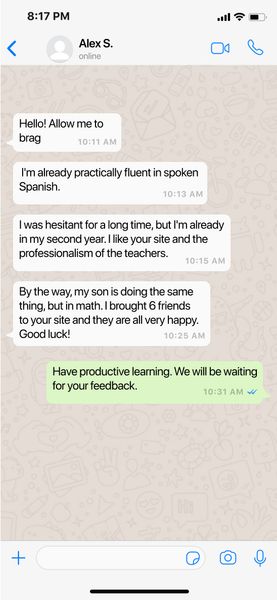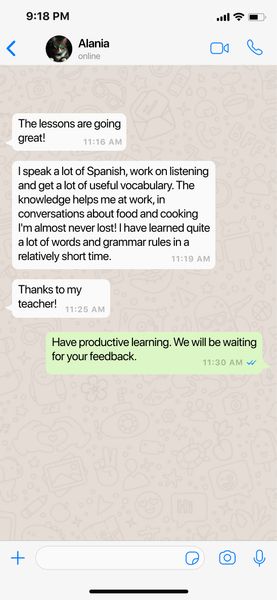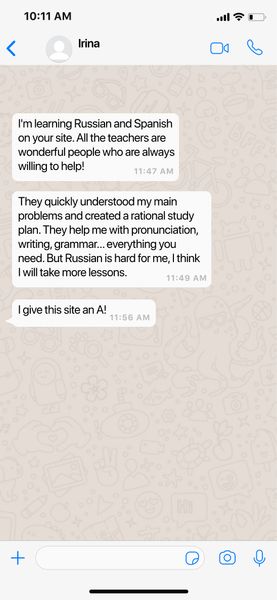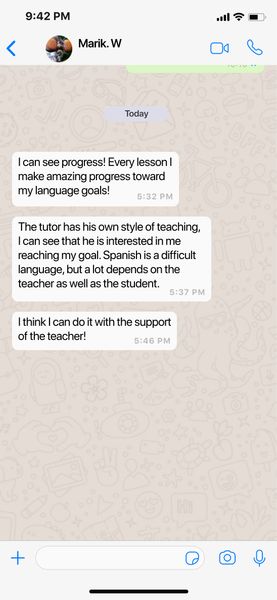I teach: Spanish
active students: 4
lessons: 1852
I have been teaching Spanish to foreigners for over 11 years. I love teaching and I'm also a language fanatic, so I know that learning a language can sometimes be challenging.
Teacher's specialization:
Spanish for conversation
Business Spanish
Spanish for study
Spanish for travel
DELE exam preparation
Spanish teacher
Spanish matriculation
Teacher's specialization:
Spanish for conversation
Business Spanish
Spanish for study
Spanish for travel
DELE exam preparation
Spanish teacher
Spanish matriculation
Eitan
Ernesto is a very friendly and patient teacher. He makes learning Spanish so much fun and easy. I always enjoy studying with him. The lessons are well structured. Notes and homework are given, so I can easily repeat all the topics and vocabulary I have learnt in the lessons.
I teach: Spanish
active students: 3
lessons: 1986
I love my job! I see that you are looking for a Spanish teacher, right? Then try one of my classes before looking any further!
Teacher's specialization:
Intensive Spanish online
Business Spanish
Spanish for study
Spanish for travel
DELE exam preparation
Spanish teacher
Spanish lessons for advanced students
Teacher's specialization:
Intensive Spanish online
Business Spanish
Spanish for study
Spanish for travel
DELE exam preparation
Spanish teacher
Spanish lessons for advanced students
Olivia
Thanks to Mariana, I have seen the possibilities and potential of myself in learning Spanish. I hope I will continue to study Spanish with Mariana and will soon be able to reach my goal of speaking Spanish fluently as I want to. Thank you again for your help over the past 6 months.
I teach: Spanish
active students: 5
lessons: 2853
Whether you are a beginner or an able student, I will tailor the lessons to suit your needs and place a strong emphasis on communication.
Teacher's specialization:
Intensive Spanish online
Business Spanish
DELE exam preparation
SIELE exam preparation
Spanish course
Spanish matriculation
Teacher's specialization:
Intensive Spanish online
Business Spanish
DELE exam preparation
SIELE exam preparation
Spanish course
Spanish matriculation
Rosa
Another great class with Elena. She has such a good approach that I feel comfortable, but at the same time I can understand so much more than before. She is amazing to work with and I recommend her to everyone!!!
I teach: Spanish
active students: 4
lessons: 2984
Do you want to become fluent in Spanish? I'll help you create a plan and help you determine which strategies are effective for you and which are not. With me, you will focus on lessons that will allow you to achieve satisfactory results.
Teacher's specialization:
Spanish for conversation
Intensive Spanish online
Business Spanish
Spanish for study
Spanish for travel
DELE exam preparation
SIELE exam preparation
Spanish teacher
Spanish course
Spanish matriculation
Spanish lessons for advanced students
Teacher's specialization:
Spanish for conversation
Intensive Spanish online
Business Spanish
Spanish for study
Spanish for travel
DELE exam preparation
SIELE exam preparation
Spanish teacher
Spanish course
Spanish matriculation
Spanish lessons for advanced students
Michael
Working with Javier is a pleasure. He imparts his knowledge, encourages you and shows a genuine dedication to learning. He makes you feel like you are talking to a friend, not learning. I wholeheartedly recommend this instructor.
I teach: Spanish
active students: 2
lessons: 9875
Professional Spanish Tutor with 25 Years of Experience for All Levels
Teacher's specialization:
Spanish for study
Spanish for travel
DELE exam preparation
Spanish course
Corresponds to Oxford certification
Teacher's specialization:
Spanish for study
Spanish for travel
DELE exam preparation
Spanish course
Blanca
Carmen is a wonderful person and a great teacher. She divides the class into segments, each one has a specific topic. Carmen explains everything clearly and in details. I enjoy learning, and every time I get a lot of new knowledge. My level of Spanish has improved dramatically in three months of studying.

Need help choosing a tutor?
If you cannot find a suitable tutor, we will do our best to provide the assistance based on your needs
Leave a request- Home
- Spanish
Why Learn Spanish Online with Language.online
Learning Spanish online has become one of the most popular and effective ways to acquire a new language, especially when accompanied by native-speaking tutors. On the Language.online platform, you receive a personalized learning experience tailored to your needs, your pace, and your schedule.
The Spanish lessons are conducted live via video, allowing you to practice speaking, listening comprehension, and vocabulary from the very first session. In addition, every tutor builds a customized study plan based on your level, goals, and learning style.
The platform offers a wide variety of professional Spanish tutors from around the world, allowing each student to find the right instructor—whether for basic learning, academic preparation, international work, or improving speaking confidence.
Benefits of learning with Language.online:
- Native Spanish-speaking tutors
- Fully personalized private lessons
- Flexible scheduling and an easy booking system
- Real speaking practice in every session
- Engaging and interactive learning experience
Teaching Methods in Spanish Courses at Language.online
The teaching methods on the platform are based on the principles of active learning—focusing on speaking, listening, and practicing real-life situations. From the very beginning, students can use Spanish in a practical way, which strengthens confidence and understanding of the language.
Each lesson incorporates digital exercises, live conversations, role-play activities, and study materials designed by experts in language instruction. This approach helps learners absorb the material naturally and more efficiently than with traditional methods.
Tutors also use advanced resources—presentations, videos, audio recordings, and authentic texts from Spain and Latin America. This dynamic approach suits all ages and proficiency levels.
Main teaching methods:
- Speaking practice in everyday situations
- Listening to authentic Spanish texts
- Thematic vocabulary expansion
- Grammar taught clearly and accessibly
- Writing and reading comprehension practice
Learning Path – From Zero to Full Mastery
With Language.online, you can progress from basic Spanish to a professional level through a personalized learning path created specifically for you. Tutors guide you every step of the way, ensuring steady and clear progress—from foundational skills to fluent communication.
Beginner-level lessons include basic vocabulary, self-introductions, simple sentence structure, and essential verb tenses. At advanced levels, learning includes complex texts, extended dialogues, professional conversations, and exam preparation.
The methodology is based on clear goals at every stage, allowing learners to track their progress and transition smoothly across CEFR levels A1–C2.
CEFR Levels – Overview:
- A1 – Essentials of the language, basic vocabulary, daily expressions
- A2 – Expanded vocabulary and simple communication
- B1 – Good understanding and conversations on general topics
- B2 – Fluent communication and deeper comprehension
- C1 – Professional-level Spanish, complex expression, academic language
- C2 – Near-native mastery and highly advanced expression
How to Choose an Online Spanish Tutor
Choosing the right tutor is a key factor in learning success. At Language.online, you can filter tutors by experience, teaching style, accent, professional specialization, and how well they match your goals—from beginner learning to exam preparation or business conversations.
It’s recommended to select a tutor who emphasizes active use of the language, challenges you to speak, and provides continuous feedback. You should also check lesson availability, teaching methods, and the tutor’s pedagogical approach.
Choosing a tutor is simple—browse the tutor profiles, watch the introduction videos, and book a trial lesson to ensure a perfect fit.
Tips for choosing a tutor:
- Look for a native Spanish-speaking tutor
- Check experience with students at your level
- Ensure availability that suits your schedule
- Read student reviews
- Start with a trial lesson before committing
Long, High-Converting CTA
Now Is the Time to Master Spanish – Start Learning with the Best Tutors!
If you’ve always dreamed of speaking Spanish confidently, understanding native speakers, and using the language at work, in studies, or while traveling—now it’s easier than ever. On the Language.online platform, you’ll enjoy a fully personalized learning experience with professional native-speaking tutors, tailored study plans, and a flexible, user-friendly scheduling system.
All you need to do is choose a tutor who fits your pace and goals, book a trial lesson, and start practicing real Spanish from day one. Don’t postpone it—every lesson brings you closer to full mastery of the world’s second-most spoken language.
Spanish language test preparation
Purpose of learning Spanish
The support team will help you find the best teacher
Questions and answers
Why is it important to learn Spanish?
There are currently approximately 580 million Spanish speakers worldwide; that's 7.6% of the world's population. In fact, Spanish is the second most widely spoken language in the world and the third most widely used language on the Internet after English and Chinese.
How long does it take to learn Spanish?
It takes the average person between 575 and 600 hours to get from zero to fluent Spanish. Fluency is difficult to determine because everyone progresses at different rates and there are many contributing factors.
Why are the exclamation points and question marks inverted in Spanish?
The inverted question mark was adopted around 1754, when the Royal Academy recommended the use of this symbol to indicate the beginning of a question in written Spanish, such as "¿Cuántos años tienes?" The institution also ordered the same system of inverted symbols for exclamatory expressions using the symbols "¡" and "!"
Does Spanish have dialects?
Spanish spoken in Spain is different from Spanish in Argentina. Spanish is quite varied when it comes to spoken form, varying to different degrees from one country to another, especially in pronunciation and vocabulary. Variations exist not only between European Spanish and Spanish in the Americas, but also in many different dialects of Spain and Latin America.
What is DELE?
DELE is an official document certifying the degree of competence and knowledge of Spanish, issued by the Instituto Cervantes on behalf of the Spanish Ministry of Education. It corresponds to the Common European Framework of Reference for Languages (CEFR) and ranges from A1 (Beginner) to C2 (Proficiency).















